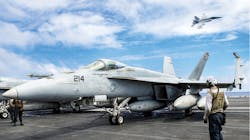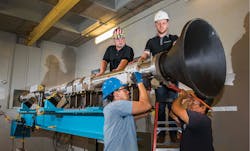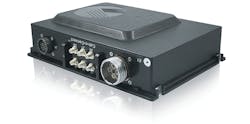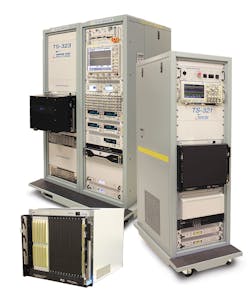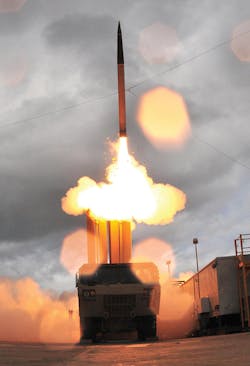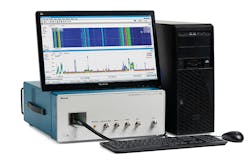Rapidly advancing technologies and emerging threats are driving increased investment in modern test and measurement tools.
Military and aerospace organizations focus on building readiness and filling capability gaps to ensure multi-domain superiority across land, air, sea, space, cyberspace, and the electromagnetic spectrum. Test and measurement equipment plays a key role in achieving these goals, and is the focus of widespread modernization efforts.
Cybersecurity
Aerospace and defense systems integrators are demanding cybersecurity in all test sets, explains Stephen Sargeant, CEO of Marvin Test Solutions Inc. in Irvine, Calif. "It is best achieved with a combination of software, firmware, and hardware."
Security is paramount in military communications and mission systems, prompting U.S. Navy officials to partner with the BAE Systems Intelligence & Security sector in McLean, Va., on a variety of vital communications and electronics equipment in support of the Naval Warfare Center Aircraft Division (NAWCAD) in Patuxent River Naval Air Station, Md.
Navy personnel perform preflight checks on an F/A-18E Super Hornet aircraft. (Photo: U.S. Navy)
The 22-month, $76 million contract calls for BAE Systems to design and maintain communications and electronics platforms, as well as test and certify equipment for NAWCAD's Special Communications Mission Solutions Division. Users include the U.S. Army, Air Force, Joint Special Operations Forces, and other Department of Defense (DOD) and federal government agencies.
"Our customers are always looking for solutions that are designed and built to the most rigorous specifications," says Marvin Test's Sargeant. "Mil-spec is a perfect example of that when the systems will be deployed or employed under adverse conditions." The company is working toward certification to the AS-9100D Quality Management Systems-Requirements for Aviation, Space, and Defense Organizations international standard published by SAE International.
Sargeant recommends selecting products and platforms developed with systems integrators' current and future requirements in mind. "My best advice would be to select solutions that feature commonality and open architecture. Commonality streamlines logistics and makes it possible to reduce the cost of training and relying on fewer supply chains - always a desirable outcome."
Sandia tests ensure avionics can withstand shock from stage separation in flight. (Photo: R. Montoya)
"Open-architecture test platforms, such as PXI, offer the flexibility to configure the system you need today, as well as the ability to upgrade and add resources as new requirements emerge," Sargeant continues. PXI is a rugged PC-based platform for measurement and automation systems, developed by National Instruments in Austin, Texas, that combines PCI electrical-bus features with the modular, Eurocard packaging of CompactPCI, specialized synchronization buses, and key software features.
As requirements continue to grow and change, aerospace and defense organizations are increasingly adopting workflow tools offering electronic design automation (EDA), product life cycle management (PLM), requirements traceability, and design verification capabilities from vendors such as Jama Software in Portland, Ore.; Mentor (a Siemens Business) in Wilsonville, Ore.; and others.
Requirements
The growing complexity and demand for multifunctional, multi-mission capabilities in modern aerospace and defense electronics can result in conflicting system requirements as well as test and measure challenges.
It pushes systems designers toward integrated systems, says David Njuguna, technical marketing manager at Tektronix in Beaverton, Ore. Defense organizations today are deploying "integrated systems for communication, visualization, and threat detection and management, which are enabled by a distributed network of low-cost, low size, weight, and power consumption (SWaP) sensors designed purely for detection, coupled with high-performance analyzers for deeper exploration and decision-making," he says. Systems supporting these defense trends require broad frequency range, wide instantaneous bandwidth, and real-time streaming and processing capabilities.
"Although the systems supporting these defense trends have some common requirements, including real-time streaming and processing capabilities, they also have some diverging requirements," Njuguna says. The distributed networks require low SWaP and low cost while still maintaining signal fidelity, and the performance receiver/analyzer requires higher resolution, wider instantaneous bandwidth, and deeper capture memory, including more powerful real-time processing capabilities.
THAAD weapon system intercepts target. (Photo: DOD)
Tektronix USB real-time spectrum analyzers (RSAs), such as the RSA306B or RSA500, are deployed in remote locations as an emissions-characterization network to identify interferers, rogue emissions, and adversarial threat or communication signals, Njuguna says. "The decision-making occurs either at the sensor itself, or using the Tektronix RSA5000 series or RSA7100 as the high-performance analyzer to capture and perform deeper analysis on signals of interest initially discovered by the distributed network of USB RSAs."
USB RSAs also are being deployed on ships and aircraft as the front end for legacy receivers evaluating the electromagnetic environment and to help make decisions on radiation hazards, emission control, and other electromagnetic interference (EMI) protection for sensitive equipment, Njuguna adds.
"For the distributed networks, while intended to be low-cost and low-SWaP, you must still consider the necessary signal fidelity and the ability to stream data when choosing your sensor," Njuguna says. "For the higher-performance analyzer, consider the ability to first detect the signal of interest in a congested environment and also the need for streaming while performing deeper analysis."
Kontron's Cab-n-Connect A100 is part of Lufthansa Systems' testbed on FlyingLab flights.
Weapon systems
Aerospace and defense organizations are doing more with less, and require the same of their electronics systems and their test and measurement tools. Scalability and flexibility are key attributes of a modern test system as users look to apply one solution for as long as a decade to test vehicles, ships, and aircraft.
Ensuring the readiness of weapons systems and missile defenses is a top concern today. Instruments from Marvin Test Systems, for example, are designed to support test requirements for maintenance and sustainment of missile systems, helicopters, fixed-wing aircraft, and unmanned aerial vehicles (UAVs). The company supplies weapon system test solutions tailored to maintenance levels from production, to the flight line, to the depot.
Legacy test and measurement equipment suffers from major reliability and obsolescence issues, as well as design limitations that curtail their ability to support future requirements. These are among the reasons that defense organizations worldwide are replacing decades-old test and measurement equipment in favor of more modern, future-proof designs.
Officials of the Naval Air Warfare Center Aircraft Division in Lakehurst, N.J., sought to replace the aging A/E37T-35A common rack and launcher test set (CRALTS) used to assess missile and weapons launchers on the F/A-18 jet fighter bomber and other combat aircraft.
They found their solution at Behlman Electronics in Hauppauge, N.Y., awarding a $21.7 million contract for as many as 180 Common Aircraft Armament Test Sets (CAATS) and 100 Pure Air Generator System Adapter Sets (PAGS PAS). The new weapons-launcher test and measurement equipment will help test and troubleshoot U.S. Navy, Marine Corps, and international military bomb racks, missile launchers, pylons and emerging weapons carriage devices across most aircraft weapons systems at the intermediate maintenance level.
Marvin Test Systems' GENASYS is used to test board- and box-level satellite subassemblies.
Personnel in the Navy, Marine Corps, and militaries of Spain, Italy, Finland, and Kuwait will use the CAATS system to test rack and launcher weapons interfaces of the aircraft to ensure proper system functionality and safety prior to loading ordnance. The PAS interfaces with the CAATS to test LAU-7 and LAU-127 high-pressure pure air generator (HiPPAG) weapons launchers, and provides pressure test capability to evaluate emerging pneumatic pressure-release launchers, such as the Joint Miniature Munitions Bomb Rack Unit.
The LAU-7 air-to-air missile launcher carries and deploys the AIM-9 heat-seeking missile and instrumentation pods on Navy and Marine Corps F/A-18 fighter-bombers. The LAU-127 missile rail launcher enables the F/A-18 to carry and launch the radar-guided AIM-120 Advanced Medium-Range Air-to-Air Missile and AIM-9X advanced heat-seeking missile, and provides the electrical, mechanical, and data-transfer interface between missiles and aircraft cockpit controls and displays.
Missile defense
The U.S. Missile Defense Agency (MDA), the U.S. Army, and industry joined forces at the end of July 2017 to test a critical missile defense capability, the Terminal High Altitude Area Defense (THAAD) system, built by an industry team led by Lockheed Martin in Bethesda, Md.
OneWeb Satellites begins end-to-end validation, testing, and integration of its first satellites.
The THAAD system at Pacific Spaceport Complex Alaska in Kodiak, Alaska, detected, tracked, and intercepted an intermediate-range ballistic missile (IRBM) target, achieving its first IRBM intercept.
During the test, a U.S. Air Force C-17 Globemaster III military transport aircraft air-launched a ballistic missile target over the Pacific Ocean north of Hawaii. The THAAD radar detected, acquired, and tracked the target, after which the THAAD system launched an interceptor that destroyed the target's reentry vehicle with the force of a direct collision.
This test marked the 14th successful intercept in 14 attempts for the THAAD system since 2005. The Ballistic Missile Defense Operational Test Agency, Department of Defense Operational Test and Evaluation, Army Test and Evaluation Command, U.S. Army, Joint Forces Component Command for Integrated Missile Defense, U.S. Air Force, U.S. Coast Guard, and Pacific Spaceport Complex Alaska (PSCA) provided support. MDA officials anticipate deploying 50 THAAD weapon systems globally by September 2018.
The THAAD system is rapidly deployable, mobile, and interoperable with other Ballistic Missile Defense System (BMDS) elements, including Patriot/PAC-3, Aegis, forward-based sensors, and the Command, Control, Battle Management and Communications system. It employs RS255 2U and RS378 3U rugged servers from Crystal Group in Hiawatha, Iowa, to better withstand transport across various terrains, use in harsh environments, and extreme shock and vibration.
The Terminal High Altitude Area Defense (THAAD) system is undergoing testing.
Shock and space
Engineers are improving current methods of testing critical aerospace components and systems, such as shock tests of avionics and space launch system or rocket parts.
Engineers at Sandia National Laboratories in Albuquerque, New Mexico, have demonstrated a way to test rocket parts to ensure that rocket avionics can withstand the shock from stage separation during flight. Designed to be more environmentally friendly than current techniques, the Alternative Pyroshock Test uses a nitrogen-powered gas gun to shoot a 100-pound steel projectile into a steel resonant beam, which transfers energy through a resonant cone attached to the part being tested. The resulting energy transfer mimics the conditions of stage separation in space. The first test of this type using flight hardware was completed last spring.
Previous pyroshock tests to ensure aerospace parts were ready for the rigors of flight used explosives encased in lead to provide the impacts to parts needed for such experiments, Sandia Mechanical Engineer Mark Pilcher explains. The lead and explosives were environmental hazards, making cleanup costly and time-consuming.
"We recognized early in the program that we need to seek out alternative test methods in order to reduce our hazardous work exposure, minimize environmental waste, and develop a controlled and repeatable test capability," Pilcher says.
The Tektronix RSA7100A wideband signal analyzer provides real-time spectrum analysis.
"The same concept can be used for a variety of defense and space applications," Sandia Mechanical Engineer Bo Song says. "This provides a new path for pyroshock testing, but very clean and more controllable and will save a lot of costs."
Satellites
Testing components and systems to ensure they will withstand the rigors of space, include shock and vibration during launch and potentially decades in orbit amid damaging radiation. This is no small feat - particularly while keeping pace with the fast-moving satellite sector.
"The satellite communications industry is undergoing rapid changes and growth," says Darren McCarthy, aerospace & defense technical marketing manager at test house Rohde & Schwarz America in Beaverton, Ore. "The evolution of satellite technology and support for NewSpace innovations are driven by the numerous commercial ventures in space and near space. It is forcing the satellite communications industry to break from traditional test and measurement methods and take a new look at commercial test practices to meet demand."
Technology transfer trends extend to test and measurement. "A forcing function in the satellite communications industry in the development of waveform technology and antenna beam steering is very synergistic to developments necessary to support commercial 5G technology," McCarthy says. In supporting NewSpace applications for fast data communications, consider the radio-frequency (RF) performance - phase noise, bandwidth, level flatness, and dynamic range as measured by the error-vector-magnitude (EVM) performance - and ease of use of test equipment, he advises.
Speed of test and reduced uncertainty are influencing test and measurement equipment selection. "Speed of test has always been a big driver in satellite communications and, with the increased volume and focus on reduced cost of test, this is still a focus of payload test customers," McCarthy explains.
"Measuring spurious emissions, especially on the launch vehicle, is very time consuming using traditional spectrum analyzers. Emission limits can be as low as -140 decibel-milliwatts (dBm) across many gigahertz of bandwidth to avoid sensitive receiver bands. This is not only for the test and evaluation phase of the payload, but also during EMI qualification," McCarthy says. "Due to the MIL-STD 461G explicit introduction of time-domain scan test methodology as an accepted technique, in one space vehicle test case, this enabled several weeks of testing to be condensed into a few hours."
COMPANY LIST
Abaco Systems
Huntsville, Ala.
http://www.abaco.com
Astronics Corp.
East Aurora, N.Y.
http://www.astronics.com
Behlman Electronics
Hauppauge, N.Y.
http://www.behlman.com
DTS Diversified Technical Systems
Seal Beach, Calif.
http://www.dtsweb.com
Fairview Microwave
Allen, Texas
http://www.fairviewmicrowave.com
Kaman Precision Products
Middletown, Conn.
http://www.kamansensors.com
Keysight Technologies
Santa Rosa, Calif.
http://www.keysight.com
Marvin Test Solutions
Irvine, Calif.
http://www.marvintest.com
Meggitt Sensing Systems
Irvine, Calif.
https://www.meggittsensingsystems.com/
National Instruments
Austin, Texas
http://www.ni.com
Pasternack Enterprises
Irvine, Calif.
http://www.pasternack.com
Rohde & Schwarz
Columbia, Md.
http://www.rohde-schwarz.com/
Saelig Company
Fairport, N.Y.
http://www.saelig.com
TDK-Lambda Americas
National City, Calif.
http://us.tdk-lambda.com
Tektronix
Beaverton, Ore.
http://www.tek.com
Vishay Precision Group
Malvern, Pa.
http://vpgsensors.com
VTI Instruments
Irvine, Calif.
http://www.vtiinstruments.com

Courtney Howard | Executive Editor
Courtney, as executive editor, enjoys writing about all things electronics and avionics in PennWell’s burgeoning Aerospace and Defense Group, which encompasses Military & Aerospace Electronics, Avionics Intelligence, the Avionics Europe conference, and much more. She’s also a self-proclaimed social-media maven, mil-aero nerd, and avid avionics geek. Connect with Courtney at [email protected], @coho on Twitter, and on LinkedIn.
